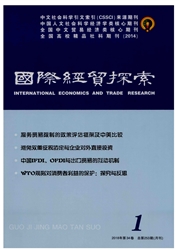

 中文摘要:
中文摘要:
战略性新兴产业面临的出口困境,使中国意识到仅依赖低成本低价格的竞争优势已难以维持其出口增长,如何培育其出口竞争新优势,是亟需破解的难题。文章运用分位数回归模型,利用战略性新兴产业上市公司数据,针对技术创新、本土市场效应与其出口的实证研究表明:整体估计中,技术创新和本土市场效应促进了战略性新兴产业出口,而前者的驱动力更强。分地区回归中,在东部和高分位点中西部地区,技术创新促进了出口,而在中西部和低分位点东部地区,存在本土市场效应; 在东部,技术创新驱动力强于本土市场效应,而中西部却与之相反。分产权性质回归中,技术创新促进了国有和非国有的出口增长,而对后者的驱动力更大,但是仅在国有企业中存在本土市场效应。上述研究为推动战略性新兴产业出口竞争新优势的培育,提供了重要政策依据。
 英文摘要:
英文摘要:
Strategic emerging industries are faced with the export predicament. China has realized that relying only on the competitive advantage of low-cost and low-price has been difficult to maintain its export growth. How to cultivate new competitive advantages of export has become a difficult problem. The research based on the quantile regression model and listed companies'data of strategic emerging industries shows that: in the whole estimation, technology innovation and home market effect have promoted export, and the driving force of the former is stronger. The regression analysis by region shows that: in the East and in the Midwest of high quantile points, technology innovation has promoted export. In the Midwest and in the East of low quantile points, there is a home market effect. In the East, the driving force of technology innovation is stronger than home market effect, while in the Midwest it is contrary. The regression analysis by property rights nature shows that: technology innovation promotes the export growth of state-owned and non-state-owned enterprises, while the latter is stronger. But only in the state-owned enterprises, there is a home market effect. The above research provides an important policy basis for the cultivation of the new competitive advantage of strategic emerging industries.
 同期刊论文项目
同期刊论文项目
 同项目期刊论文
同项目期刊论文
 期刊信息
期刊信息
